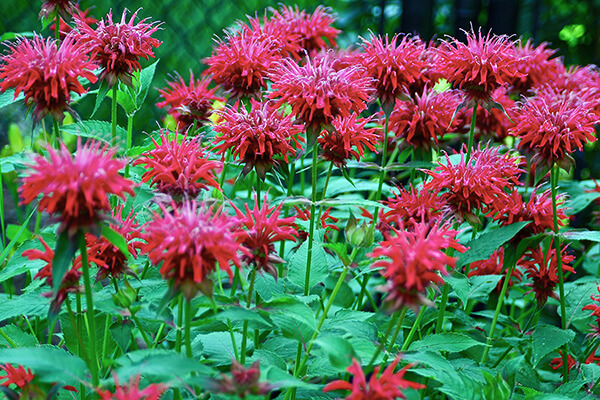HOW TO FEED A HUMMINGBIRD PART II: FLOWERS & NECTAR
This is Part II in a two-part series.
Part I of “How to Feed a Hummingbird: Insects & Protein” revealed that 80 percent of a hummingbird’s diet is comprised of insects and spiders. Eighty percent! Knowing how crucial those often maligned arthropods are to our ruby-throated hummingbirds will hopefully inspire you to embrace the bugs and add a variety of native plants to your garden.
If you are at all curious about hummingbirds you’re probably assuming the missing 20 percent or so of their diet comes from nectar — and you’d be right. Let’s explore the flowering native plants our high-metabolic friends count on for a full-on sugar rush.
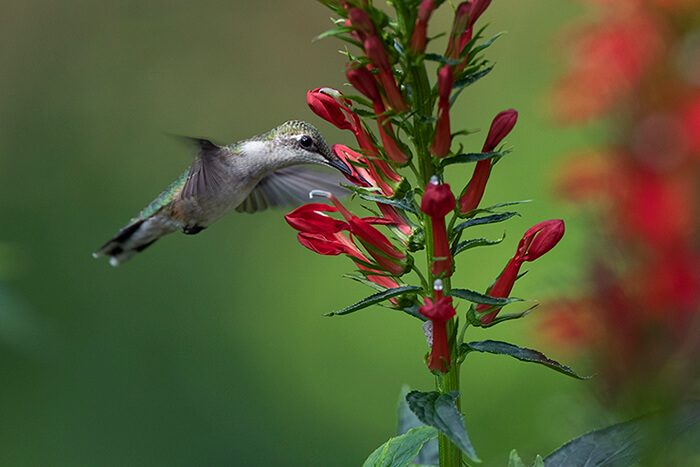
THE BIG THREE WILDFLOWER NECTAR SOURCES
Just like bees and butterflies and other pollinators, ruby-throated hummingbirds rely on a constant source of nectar from early spring into fall. Nectar is found in flowers adapted for hummingbirds: long and tubular with a typically pendulous and perchless form. These floral traits are perfect for long beaked, hovering hummers but not convenient for insects that cannot easily reach the hidden nectar. Another evolutionary adaption is the color red. Red is not seen by bees however it quickly signals keen-eyed migrating hummingbirds that a sugary treat awaits.
What combination of plants provides an overlapping progression of blooms? Potowmack Chapter President of the Virginia Native Plant Society, Alan Ford, names the following BIG THREE flowering natives as attracting and supporting our ruby-throats throughout their days in the Mid-Atlantic:
The BIG THREE:
1. Coral honeysuckle (Lonicera sempervirens)
2. Eastern red columbine (Aquilegia canadensis)
3. Cardinal flower (Lobelia cardinalis)
OUTSTANDING NATIVE NECTAR SOURCES
The following Mid-Atlantic plants, including the aforementioned BIG THREE nectar sources, are frequented by ruby-throated hummingbirds. The growing conditions and characteristics of these plants are provided to help you choose the best ones for your garden.
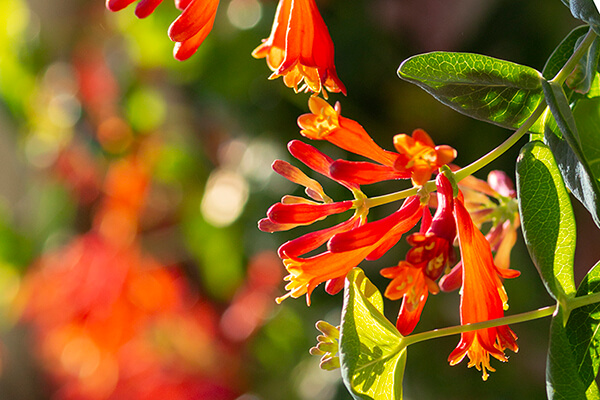
Coral honeysuckle (Lonicera sempervirens): “Lonicera should be your first go-to plant,” recommends Alan Ford. Coral honeysuckle is his number one recommended garden plant for hummingbirds and it’s also the Virginia Native Plant Society’s 2014 Wildflower of the Year: “Coral honeysuckle is widely known for its ability to attract butterflies and hummingbirds. In fact, the combination of its bright red tubular flowers with abundant nectar and little floral odor typifies the usual pattern for hummingbird-pollinated species.”
This beautiful semi-evergreen twining woody vine is one of the BIG THREE plants to have in the garden based on its long continuum of blooms, high attractiveness to hummingbirds and non-aggressive demeanor. Coral honeysuckle is also easy to grow. This vine can reach up to 20 feet so it needs a sturdy support to climb; however its height can easily be controlled by pruning.
Pruning is best done in fall, but it can also be done immediately following the first large flush of flowers. Flowering is most prolific in full to part sun. Coral honeysuckle prefers rich, well-drained moist soils and needs good air circulation to prevent powdery mildew. The red berries that follow the flowering offer food to other bird species.
Host plant info: Lonicera also hosts at least 33 native Lepidoptera (butterfly and moth) species including the snowberry clearwing moth.
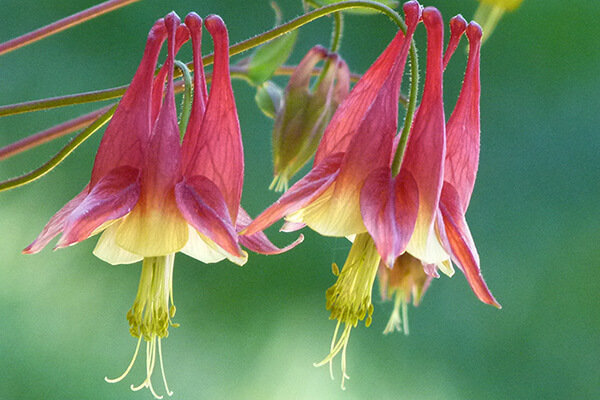
Eastern red columbine (Aquilegia canadensis): Eastern red columbine is another of the BIG THREE flowering plants for attracting and feeding hummingbirds. This spring-blooming perennial provides early nectar for hummers returning from abroad to their eastern breeding grounds. Pretty red and yellow flowers, attractive rounded leaves and low height — typically about two feet — makes this a lovely garden plant. Easy to grow in part sun or light shade, eastern red columbine is adaptable to moist or dry soils and isn’t choosy about soil type. It self sows readily. Deer and rabbits are not particularly fond of Aquilegia canadensis.
The species is the columbine for hummingbirds. Fancy hybrids or cultivars with double flowers do not provide nectar for our hummers. Aquilegia canadensis is the real deal.
Host plant info: Aquilegia supports 12 native Lepidoptera species.

Cardinal flower (Lobelia cardinalis): The outstanding cardinal flower is the third of the BIG THREE plants for hummers. This two to four foot tall perennial is an important nectar producer with a long bloom period. Its spikes begin flowering in summer and the crimson red easily continues for two glorious months. Cardinal flower is adaptable to sun or dappled shade but needs continuous moisture. It reseeds in optimum conditions.
Matt Bright, Conservation Coordinator of Earth Sangha, sheds light on why there’s often confusion over whether cardinal flower is a biennial or a perennial. “Our common native Lobelia species are a confusing bunch when it comes to longevity,” Bright explains. “Perennial Lobelias typically don’t flower their first year and instead form only a basal rosette. The following year, they will flower, set seed.
Depending on the health of the plant and site conditions, they may die back to a basal rosette or they may die entirely. Many are capable of vegetative reproduction and will create offsets or daughter plants around the original rosette. This is especially noticeable if you grow cardinal flower totally submerged where it can happily grow, but will not flower.”
You don’t have a naturally occurring moist area? Consider planting Lobelia cardinalis en masse near a water feature or birdbath. And remember to push back the leaf litter so the rosettes don’t rot over winter.
Host plant info: Lobelia is the host plant to four native Lepidoptera species and its nectar also supports bees and other insects.
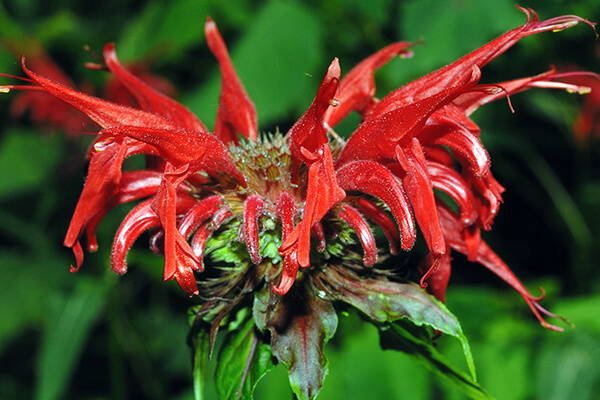
Photo by Nicholas Turland/flickr/CC.
Scarlet beebalm (Monarda didyma): Summer flowering beebalm, with its red pompom flowers, is lovely in a naturalized garden. It reaches between two to four feet tall, but like most native species, it can get taller. Scarlet beebalm grows best in full to part sun and it likes some moisture, preferring rich, acidic soil (pH<6.8). Beebalm, it is commonly noted, is susceptible to powdery mildew in hot, humid climes but it doesn’t seem to hurt the plant. Because it’s in the mint family, Lamiaceae, expect it to spread quickly by shallow-rooted rhizomes; it also spreads by reseeding. Beebalm is easy to control — simply divide and share. Its foliage, like all Lamiaceae, is not preferred by deer or other mammals.
Host plant info: Monarda is the host plant to seven Lepidoptera caterpillars.
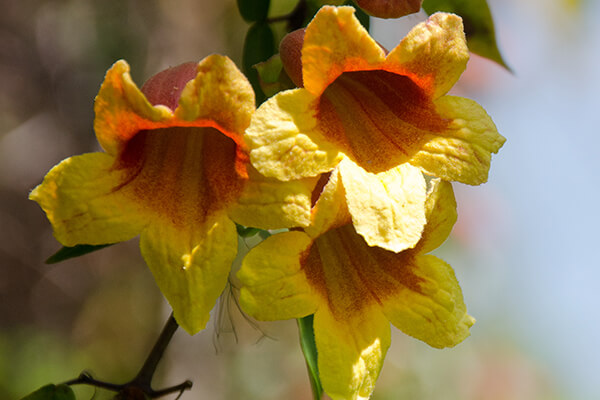
Photo by Suzanne Cadwell/flickr/CC.
Crossvine (Bignonia capreolata): The typically red and yellow-throated flowers of crossvine are an important spring nectar source for hummingbirds. A near-evergreen vine, crossvine foliage turns a purple hue in winter. It rapidly climbs brick, stone, fences and trees up to 30 – 50 feet by way of tendrils with clawed ends and is considered aggressive by some gardeners. Situate in full to part sun for best flowering. Crossvine prefers well-drained, rich, moist soil but is also found growing in dry forests and rocky woodlands.
Host plant info: According to HiltonPond.org, Crossvine is host to at least one caterpillar, that of the Rustic Sphinx Moth.
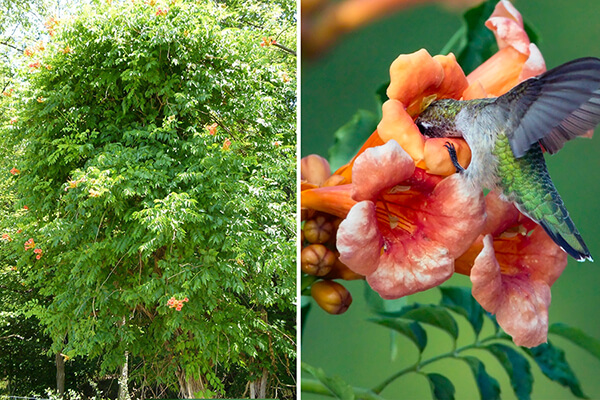
Hummingbird right: Photo by Kelly Colgan Azar/flickr/CC.
Trumpet creeper (Campsis radicans): “Not for the faint of heart,” cautions Sue Dingwell in her article More Love for Native Vines for Beautiful Native Plants. Trumpet creeper is an aggressive, vigorously growing woody vine, best planted in expansive wild areas where it can and will take over. This creeper climbs high via aerial rootlets, with older vines growing to 60 feet. It also freely spreads by deep-rooted suckers. Thoughtful planning is necessary prior to planting Campsis radicans in the average landscape. Sue writes, “I have seen only two places where homeowners successfully corralled it. One was on a tall, thick pole surrounded by a flagstone terrace. One was on a heavily supported T-shaped trellis in the middle of sandy lawn that could be mowed closely around the base. It’s possible, but it’s constant vigilance, and even then only with pre-approved barriers.”
We love this vine for its pretty two to three inch showy orange-red blooms. Trumpet creeper flowers best in full sun, is fairly drought tolerant and prefers circumneutral soil (pH 6.8 – 7.2).
HiltonPond.org considers Campsis radicans to be the best plant for hummingbirds due to its “copious amounts of nectar” and lengthy period of bloom. So if you have a stout heart and a place for trumpet creeper to sprawl and take over, then more power to you and your hummingbirds.
Host plant info: Campsis radicans is the host plant to at least one moth, the Plebeian Sphinx Moth.
MORE TUBULAR FLOWERS
Hummingbirds commonly visit flowers of colors other than red. Here are some that are definitely garden worthy and are known to be preferred by hummers.
Lyreleaf sage (Salvia lyrata) sports lavender blooms on short stalks and makes a grand groundcover. The purple-tinged leaves add interest.
Wild blue phlox (Phlox divaricata) flowers are also bluish-lavender and bloom in early spring. It’s frequently found growing in moist well-drained floodplain forests.
Great blue lobelia (Lobelia siphilitica), cardinal flower’s cousin, has similar needs as cardinal flower and the same basic habit and bloom time.
Jewelweed (Impatiens capensis) is not your usual garden plant. With dainty nodding orange flowers and succulent, tender stems, this tall annual is found naturally growing in drifts in moist woods and near shaded streams. It will reseed madly in the right conditions.
Wild bergamot (Monarda fistulosa) is similar to beebalm (Monarda didyma) but with pinkish lavender flowers. It’s more drought-tolerant than beebalm and is not fussy about soil types. Wild bergamot also provides nectar to hummingbird moths and other cool insects.
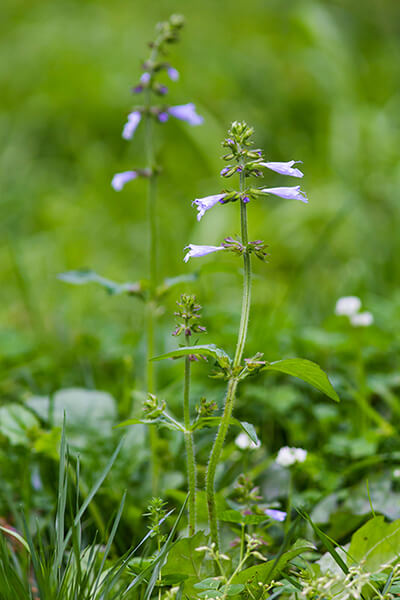
Salvia lyrata. Photo by Melissa McMasters/flickr/CC.
ATTRACT & SUSTAIN RUBY-THROATED HUMMINGBIRDS WITH NATIVE PLANTS!
They’re beautiful. They’re rugged. They’re downright indispensable. They’re native plants! Woody trees, shrubs and vines, herbaceous forbs, grasses and sedges are all essential to the well-being of our wildlife, and naturally, our ruby-throated hummers.
I created this printable handout for Plant NOVA Natives. It highlights cardinal flower, scarlet beebalm and coral honeysuckle, all wonderful garden additions. Feel free to print and share with your friends and neighbors.
Other Thoughts
Mass Those Flowers
Herbaceous species offer more wildlife value when planted in volume rather than planted singly. A large planting helps all types of pollinators to find your flowers easily and collect nectar more efficiently. Flowering herbaceous species are also more visually attractive when planted en mass.
Choose Plants that Grow Naturally in your Area
Plants indigenous to the region in which you live are best suited to survive and thrive in your garden. These locally occurring plants require zero chemical inputs and minimal resources when properly sited. Proper siting means matching the plant’s natural growing conditions with your proposed site’s conditions. Moisture, soil type, and light should all be considered for gardening success.
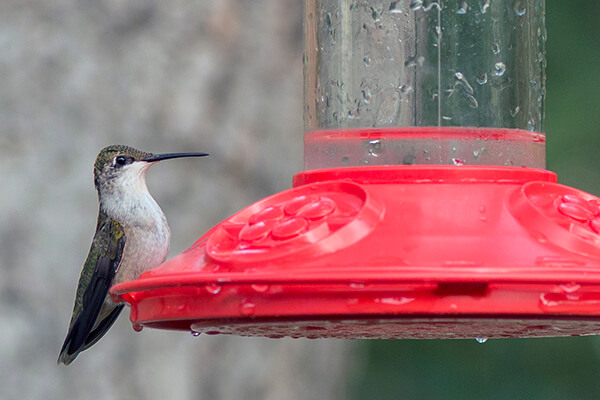
Want to Put Up a Supplemental Feeder?
A hummingbird feeder can be very rewarding but also a whole lotta maintenance. Some experts advise against putting up a feeder at all since most of us aren’t doing it right. The whole process should be strictly followed to avoid harming the hummingbirds we’re trying to help.
In the hottest days of summer I clean the feeder once a day or alternate the days I hang it. It’s possible to save resources and money by filling the feeder reservoir with a minimal amount of homemade sugar water. Making a large batch and storing it in the refrigerator for no more than a week also saves time.
The Virtual Museum in Canada offers this sound advice: Ornithologists agree that the best recipe for nectar is made from one part sugar to four parts hot water boiled for several minutes beforehand. The sugar must not be boiled to avoid creating a by-product. Adding red colouring is to be avoided.
If you notice that the mixture gets cloudy or becomes less clear, it’s due to fermentation – definitely time to change the liquid and clean the feeder. Fermentation is a biochemical reaction that takes place when sugar is present. When wine is made, bacteria in the yeast transform the sugar in the grapes into alcohol. Avoid bacteria-laced water in your feeders. Feeder solutions must be made from boiled water and replaced weekly. The feeder must also be well washed with hot water before refilling it. Hummingbirds that drink fermented nectar can develop cirrhosis of the liver!
What kind of sugar to use and not use in your feeder? Visit Smithsonian’s National Zoo & Conservation Biology Institute Hummingbird Nectar Recipe.
And if you want more detailed info, Sheri L. Williamson’s Field Guide to Hummingbirds has excellent information on the best homemade ingredients for supplementing your hummingbird’s diet.
ADDITIONAL RESOURCE: The Humane Gardener’s 10 Favorite Plants for Hummingbirds
Thanks much to Sue Dingwell and Alan Ford for their kind assistance with this article.
Updated June 16, 2022

